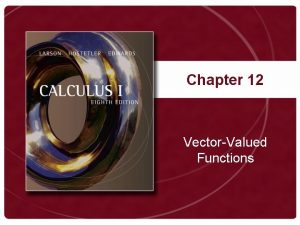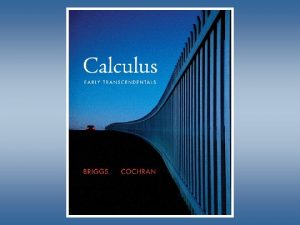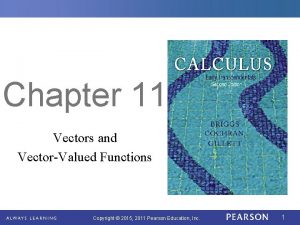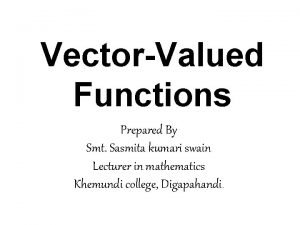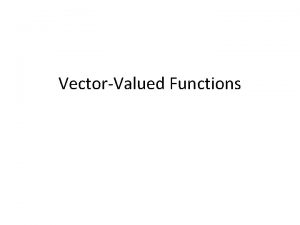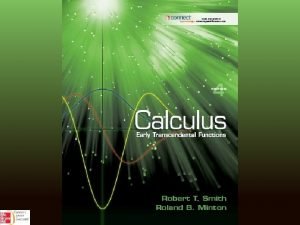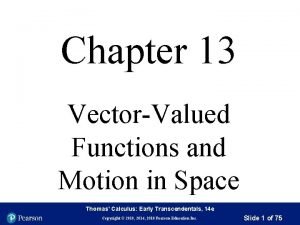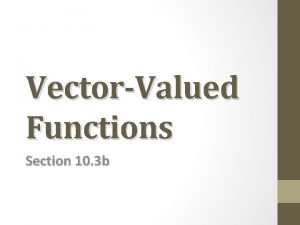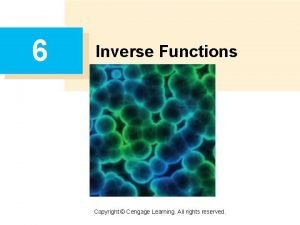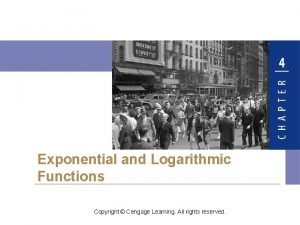12 P VectorValued Functions Copyright Cengage Learning All





















- Slides: 21

12 P Vector-Valued Functions Copyright © Cengage Learning. All rights reserved.

12. 1 Vector-Valued Functions Copyright © Cengage Learning. All rights reserved.

Objectives n Analyze and sketch a space curve given by a vector-valued function. n Extend the concepts of limits and continuity to vector-valued functions. 3

Space Curves and Vector-Valued Functions 4

Space Curves and Vector-Valued Functions A plane curve is defined as the set of ordered pairs (f(t), g(t)) together with their defining parametric equations x = f(t) and y = g(t), where f and g are continuous functions of t on an interval I. This definition can be extended naturally to threedimensional space. A space curve C is the set of all ordered triples (f(t), g(t), h(t)) together with their defining parametric equations x = f(t), y = g(t), and z = h(t) where f, g, and h are continuous functions of t on an interval I. 5

Space Curves and Vector-Valued Functions A new type of function, called a vector-valued function, is introduced. This type of function maps real numbers to vectors. 6

Space Curves and Vector-Valued Functions Technically, a curve in the plane or in space consists of a collection of points and the defining parametric equations. Two different curves can have the same graph. For instance, each of the curves r(t) = sin t i + cos t j and r(t) = sin t 2 i + cos t 2 j has the unit circle as its graph, but these equations do not represent the same curve—because the circle is traced out in different ways on the graphs. 7

Space Curves and Vector-Valued Functions Be sure you see the distinction between the vector-valued function r and the real-valued functions f, g, and h. All are functions of the real variable t, but r(t) is a vector, whereas f(t), g(t), and h(t) are real numbers (for each specific value of t). Real-valued functions are sometimes called scalar functions to distinguish them from vector-valued functions. 8

Space Curves and Vector-Valued Functions Vector-valued functions serve dual roles in the representation of curves. By letting the parameter t represent time, you can use a vector-valued function to represent motion along a curve. Or, in the more general case, you can use a vector-valued function to trace the graph of a curve. 9

Space Curves and Vector-Valued Functions In either case, the terminal point of the position vector r(t) coincides with the point (x, y) or (x, y, z) on the curve given by the parametric equations, as shown in Figure 12. 1 10

Space Curves and Vector-Valued Functions The arrowhead on the curve indicates the curve’s orientation by pointing in the direction of increasing values of t. Unless stated otherwise, the domain of a vector-valued function r is considered to be the intersection of the domains of the component functions f, g, and h. For instance, the domain of is the interval (0, 1]. 11

Example 2 – Sketching a Space Curve Sketch the space curve represented by the vector-valued function r(t) = 4 cos t i + 4 sin t j + t k, 0 ≤ t ≤ 2. Vector-valued function Solution: From the first two parametric equations x = 4 cos t and y = 4 sin t you can obtain x 2 + y 2 = 16. Rectangular equation This means that the curve lies on a right circular cylinder of radius 4, centered about the z-axis. To locate the curve on this cylinder, you can use third parametric equation z = t. 12

Example 2 – Solution cont’d In Figure 12. 3, note that as t increases from 0 to 4 , the point (x, y, z) spirals up the cylinder to produce a helix. Figure 12. 3 13

Example 2 – Solution cont’d A real-life example of a helix is shown in the drawing below. 14

Limits and Continuity 15

Limits and Continuity 16

Limits and Continuity If r(t) approaches the vector L as t → a, then the length of the vector r(t) – L approaches 0. That is, ||r(t) – L|| → 0 as t → a. This is illustrated graphically in Figure 12. 6 17

Limits and Continuity The next definition extends the notion of continuity to vector-valued functions. 18

Example 5 – Continuity of Vector-Valued Function Discuss the continuity of the vector-valued function r(t) = t i + a j + (a 2 – t 2)k a is a constant. at t = 0. Solution: As t approaches 0, the limit is 19

Example 5 – Solution cont’d Because r(0) = (0)i + (a)j + (a 2)k = aj + a 2 k you can conclude that r is continuous at t = 0. By similar reasoning, you can conclude that the vector-valued function r is continuous at all real-number values of t. 20

Limits and Continuity For each value of a, the curve represented by the vectorvalued function in Example 5, is a parabola. You can think of each parabola as the intersection of the vertical plane y = a and the hyperbolic paraboloid as shown in Figure 12. 7 21
 Cengage chapter 7
Cengage chapter 7 Delmar cengage learning medical terminology
Delmar cengage learning medical terminology Chapter 5 learning exercises medical terminology
Chapter 5 learning exercises medical terminology Cengage learning heart diagram
Cengage learning heart diagram South-western cengage learning
South-western cengage learning Chapter 13 medical math assignment sheet cengage learning
Chapter 13 medical math assignment sheet cengage learning 2009 delmar cengage learning
2009 delmar cengage learning Cengage learning heart diagram
Cengage learning heart diagram Medical terminology chapter 1 learning exercises answers
Medical terminology chapter 1 learning exercises answers Cengage learning australia
Cengage learning australia 2009 delmar cengage learning
2009 delmar cengage learning Whille
Whille Cengage learning
Cengage learning Wadsworth cengage learning
Wadsworth cengage learning Cengage learning
Cengage learning Cengage learning plant cell
Cengage learning plant cell Cengage learning
Cengage learning Cengage learning
Cengage learning Brooks cole cengage learning
Brooks cole cengage learning Chapter 7:10 respitory system
Chapter 7:10 respitory system 2014 cengage learning accounting answers
2014 cengage learning accounting answers Cengage learning
Cengage learning






















